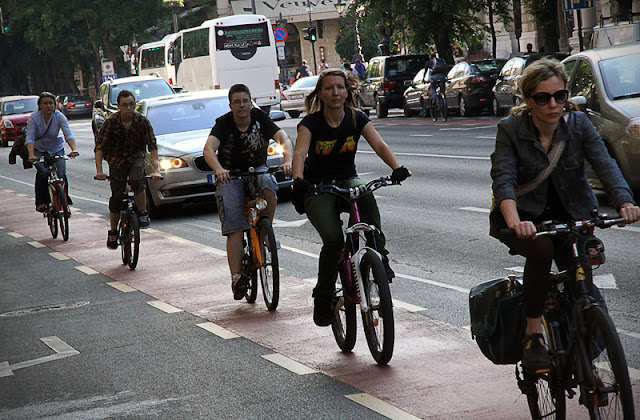 |
| Artist's conception of the refashioned Ferenciek tere. View from the south side of Ferenciek tere looking down Kossuth Lajos ut toward bridge. Image is taken from a 3-D montage at the project website. |
According to the description published on the website of the Budapest Transport Centre (BKK), the changes will make for "a much more livable, cleaner and more attractive downtown environment" that will make it worthy of its place along the capital's touristic and recreational belt.
 | ||
| Ferenciek tere today: the only way for pedestrians to cross it is to go down through the underpass. |
 |
| Ferenciek tere AFTER: The project would replace the underpass with a level crossing that's more accessible to everyone. |
From cyclists' point of view, though, what sticks out is the absence of any bike lanes along the Kossuth Lajos utca. It's ironic that while the project includes upgrades to all the side streets in the area, it does hardly anything to the major artery of Kossuth Lajos, the main source of the neighbourhood's environmental problems.
Four local environmental groups have therefore criticised the project because it does little to alleviate the "the terribly noisy, polluted motorway atmosphere." In a joint statement, reported on hvg.hu, the groups say that although they supported the project throughout preparatory discussions, their main concerns were always for bike accommodation on Kossuth Lajos (and Rákóczi út -- the whole length of the street between Keleti Station and Erzsébet hid) along with the realigning of bus routes down the centre of the street (this as a preliminary measure paving the way for the return of tram service).
Bike accommodation on Kossuth Lajos has been a priority of the bicycle lobby at least since the mid-90s. Removing (some) space from cars and giving it over to cyclists and pedestrians would restore life to the street, rehabilitate local retail and make for a huge improvement in residents' lives. But at every opportunity, including a major road resurfacing about eight years ago, officials at City Hall have said no. With a straight face, they say there's no room for bicycles, despite this street being the widest arterial in the city.
This enormous urban freeway, with its six lanes of fast-moving, heavy motor traffic, now cuts downtown in two, and makes going from one side to the other a hassle -- certainly if you're on a bike. I hope the upcoming project at Ferenciek tere is a first step toward solving the problem, and not the city's final word on it.










